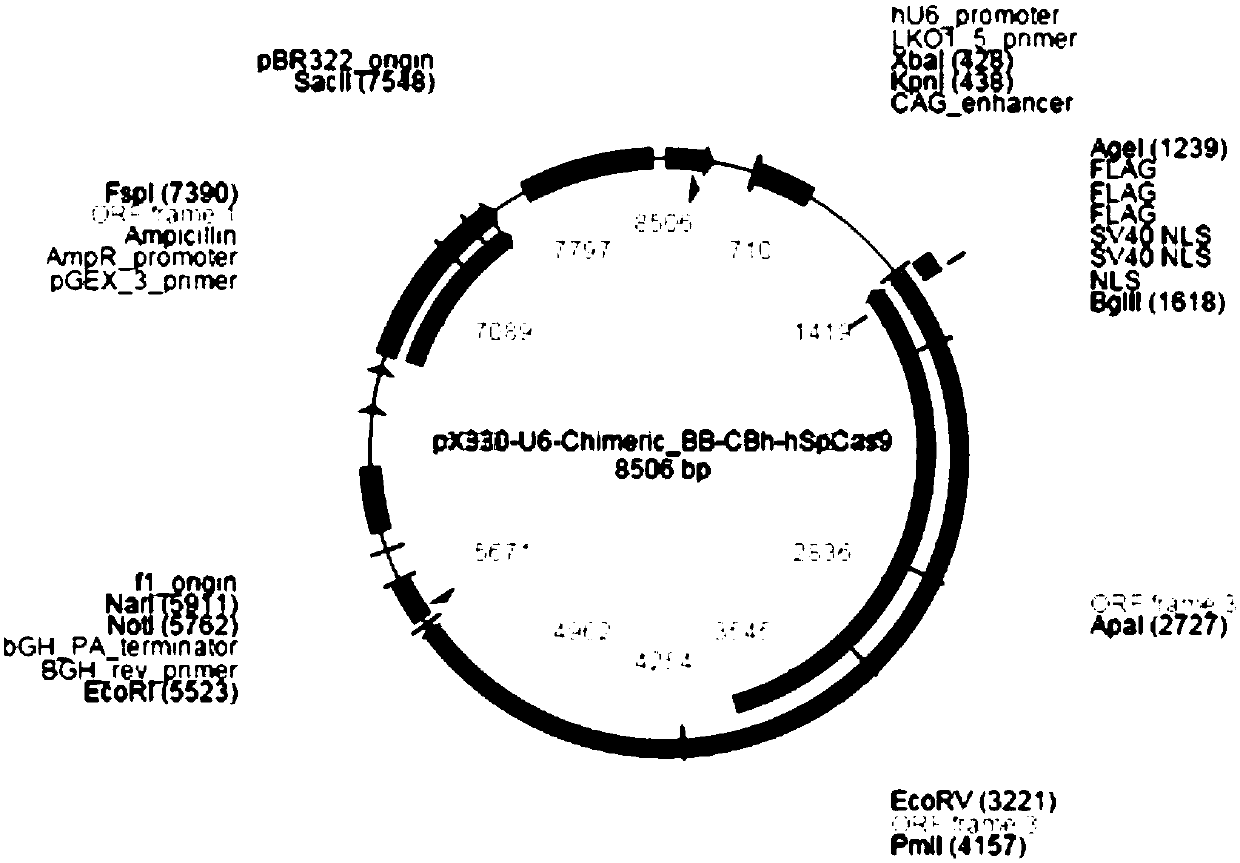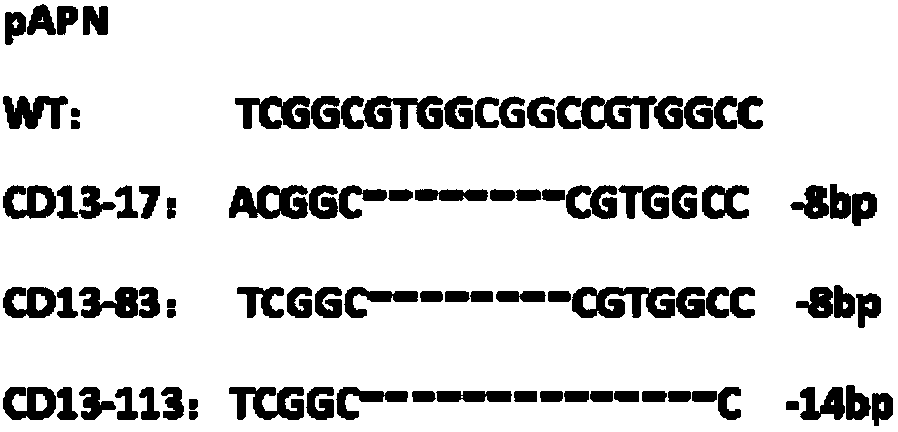Method for preparing CD13 knockout porcine fibroblast and gene-edited pig
A fibroblast, gene knockout technology, applied in the field of gene editing, can solve the problems of not being effectively controlled, economic losses in the pig industry, losses in the pig industry, etc., to improve the efficiency of knockout, high accuracy, and reduce operation effect of difficulty
- Summary
- Abstract
- Description
- Claims
- Application Information
AI Technical Summary
Problems solved by technology
Method used
Image
Examples
Embodiment 1
[0036] Example 1 Construction of the CRISPR / Cas9 targeting vector targeting the CD13 gene
[0037] 1. First lock the exon of the porcine CD13 gene as the targeting region, and design multiple targeting sites (gRNA) through software, and their sequences are target sequence 1: gcatcctcctcggcgtgg (SEQ ID NO: 1); target sequence 2: caagggattctacatttcca (SEQ ID NO: 2); Target sequence 3: ttctacatttccaaggccct (SEQ ID NO: 3).
[0038] 2. Synthesize complementary paired oligonucleotides according to the gRNA sequence, as shown in the table below, the lowercase letters are restriction sites.
[0039] Table 1 Oligonucleotides complementary to gRNA sequences
[0040]
[0041]
[0042] 3. The constructed CRISPR / Cas9 targeting vector targeting the CD13 gene, the pX330 vector backbone is as follows: figure 1 As shown, the specific construction method is as follows:
[0043] (1) Treat the synthesized oligonucleotide at 98° C. for 10 minutes, and then anneal it under natural cooling ...
Embodiment 2
[0048] Example 2 Establishment of Large White Pig Fetal Fibroblast Cell Line with Gene Knockout of CD13 Gene
[0049] 1. Cell transfection
[0050] The day before the transfection, the primary large white pig fetal fibroblasts were resuscitated into a 6cm plate, and the cells could be transfected when the cells reached 70-80% confluence. The transfection step was performed strictly according to the instructions of the Basic Primary Fibroblasts Nucleofector Kit (Lonza).
[0051] 2. Detection of target shooting efficiency
[0052] After the electrotransfected cells were cultured for 48 hours, some of them were used for plating, and some of the cells were collected to extract the cell genome and perform PCR amplification to detect the targeting efficiency. The results showed that the target sequence 1 (SEQ ID NO: 1) target The efficiency was as high as 17%, while the targeting efficiencies of target sequences 2-3 (SEQ ID NO: 2-3) were 12% and 7%, respectively. Among them, targ...
Embodiment 3
[0067] Example 3 Method for preparing genome-edited pigs resistant to epidemic diarrhea virus by somatic cell nuclear transfer technology
[0068] The homozygous knockout positive cells obtained in Example 2 were used as nuclear transfer donor cells, and young pig oocytes matured in vitro for 40 hours were used as nuclear transfer recipient cells, and the nuclear transfer donor cells were transferred into enucleated oocytes , After electric fusion and activation, recombinant cloned embryos were constructed, and the cloned recombinant embryos with good development status were selected and transferred into the uterus of natural estrous large white sows for pregnancy. Surgical method The procedure of embryo transfer is ventilator anesthesia, accompanied by 2% chloral hydrate to maintain anesthesia, lying supine on the surgical rack, making a surgical incision about 10 cm long in the midline of the abdomen, exposing the ovaries, fallopian tubes and uterus, and using embryo transfer...
PUM
 Login to View More
Login to View More Abstract
Description
Claims
Application Information
 Login to View More
Login to View More - R&D
- Intellectual Property
- Life Sciences
- Materials
- Tech Scout
- Unparalleled Data Quality
- Higher Quality Content
- 60% Fewer Hallucinations
Browse by: Latest US Patents, China's latest patents, Technical Efficacy Thesaurus, Application Domain, Technology Topic, Popular Technical Reports.
© 2025 PatSnap. All rights reserved.Legal|Privacy policy|Modern Slavery Act Transparency Statement|Sitemap|About US| Contact US: help@patsnap.com



